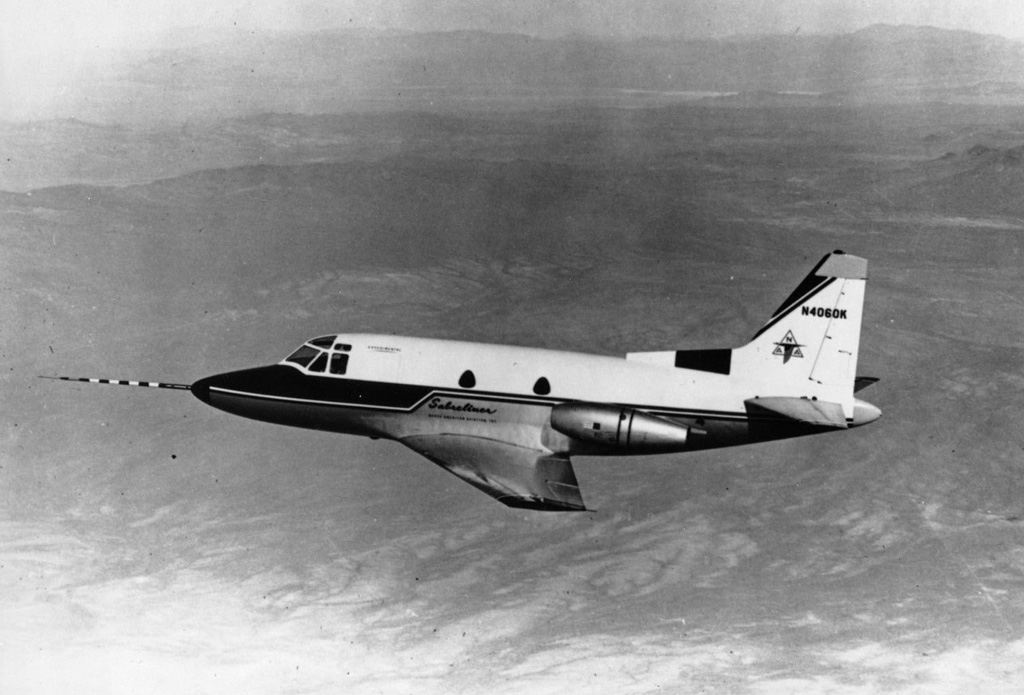
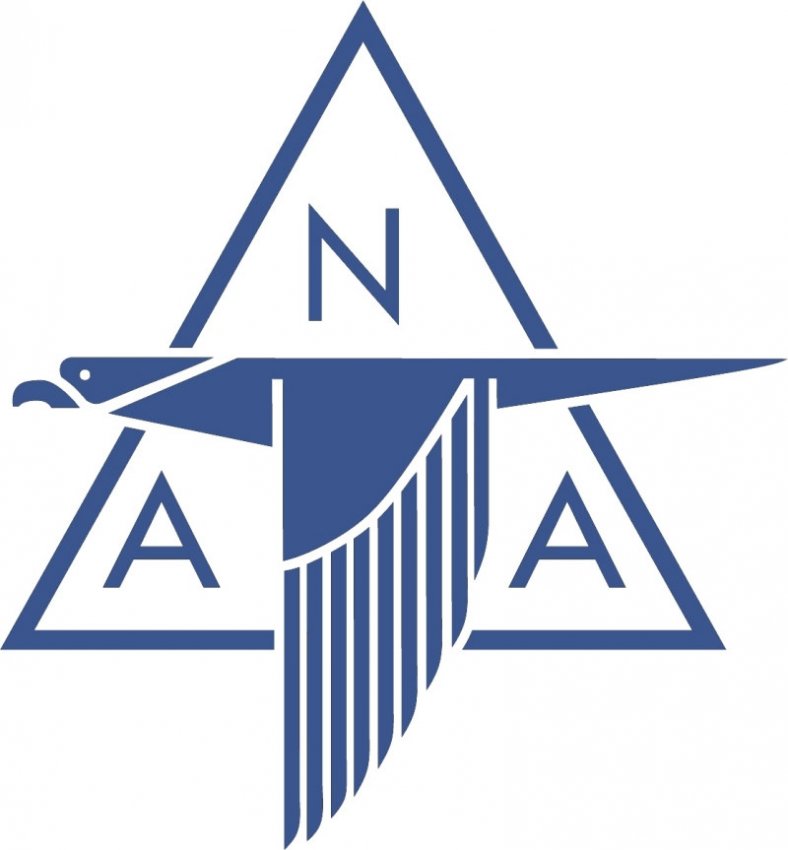
The Sabreliner had been designed and built at North American’s expense to meet the U.S. Air Force specification for the UTX, a twin-engine jet that would be primarily used as a trainer for Air Force pilots in non-flying assignments but who needed to remain proficient. It could also be used as a passenger and cargo transport.
The NA-246 was flown by two pilots and could carry up to four passengers in “club seating.”
In October 1958, the Air Force ordered the Model 265 Sabreliner into production, designated T-39A-1-NA (Serial numbers 59-2868 to -2871). This aircraft could carry up to 7 passengers. In 1962, a commercial variant of the T-39A, the Model 265 Sabreliner, was certified by the Federal Aviation Administration.
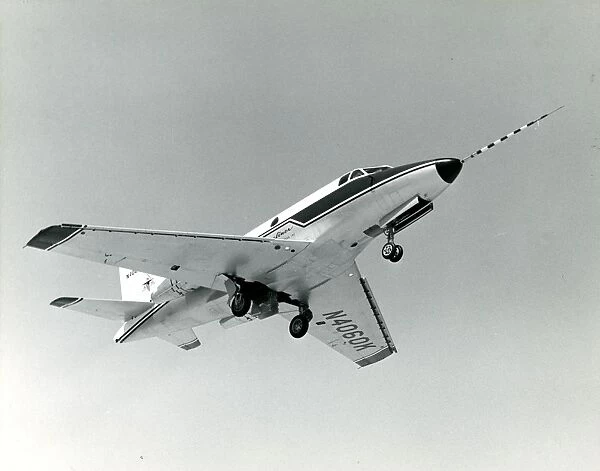
The T-39A was 44 feet (13.411 meters) long, with a wingspan of 44 feet, 6 inches (13.564 meters) and overall height of 16 feet (14.874 meters). The wings were swept at 28°. It had an empty weight of approximately 9,250 pounds (4,196 kilograms) and maximum takeoff weight of 17,760 pounds (8,056 kilograms).
The Model 246 prototype was powered by General Electric J85 turbojet engines which produced about 2,000 pounds of thrust (8.90 kilonewtons). The the production T-39A used Pratt & Whitney J60-P-3 engines, rated at 3,000 pounds (13.34 kilonewtons) for takeoff.
The T-39A had a maximum allowable airspeed (VMO) of 350 knots, indicated (KIAS) (403 miles per hour/648 kilometers per hour) from Sea Level to 21,100 feet (6,431 meters). Above that altitude, speed was restricted to 0.77 Mach.
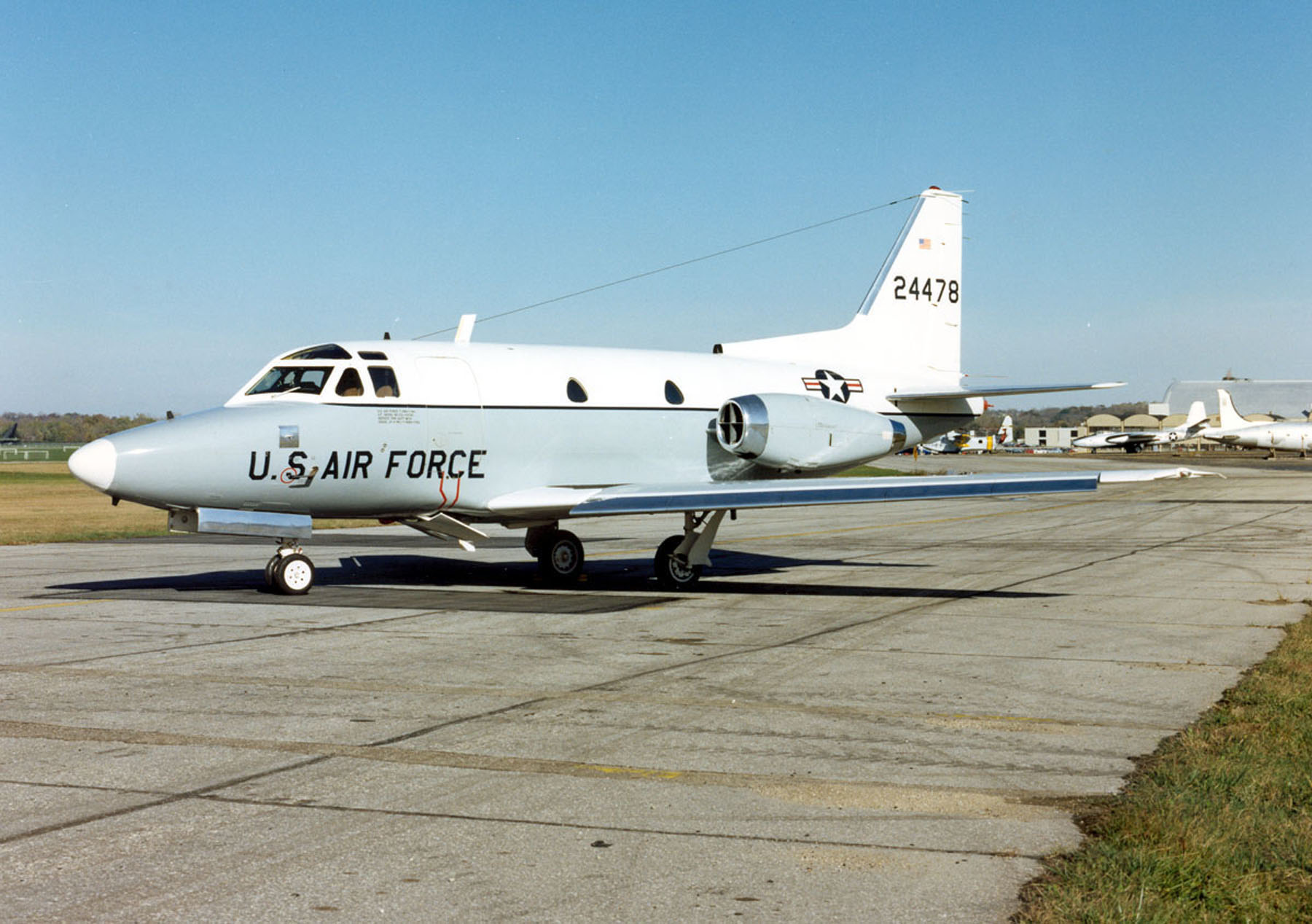
The prototype was issued an Airworthiness Certificate by the Federal Aviation Administration 25 April 1958. The registration was cancelled 30 June 1970.
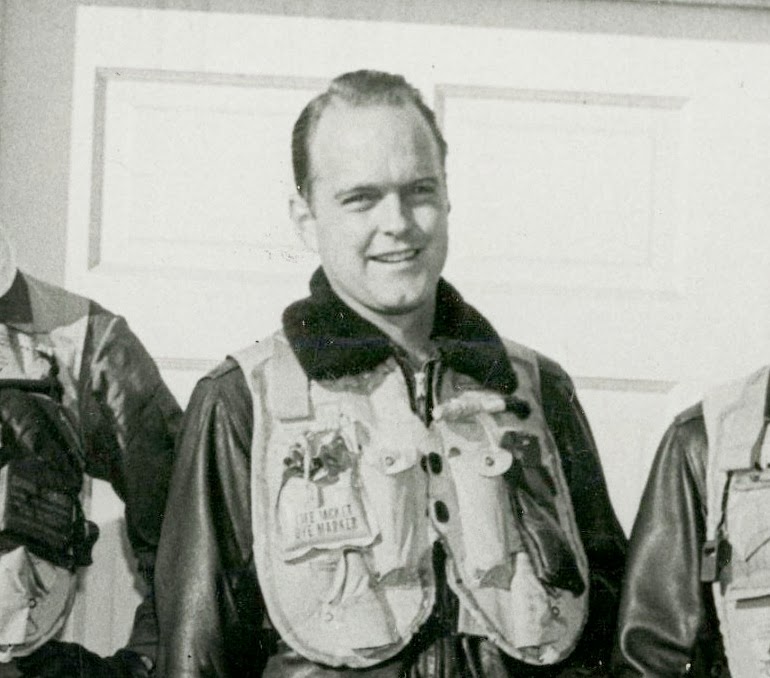
James O’Connor Roberts, Jr., was born 17 April 1924 at Washington, D.C. He was the second son of James O’Connor Roberts, an attorney employed by the United States government, and Leah Irene Harris Roberts. He attended the Peddie School in Highstown, New Jersey, and Yale University, where he was a member of the Kappa Phi Sigma (ΚΦΣ) and Chi Psi (ΧΨ) fraternities.
Roberts enlisted in the United States Army Air Forces as an aviation cadet in February 1943.¹ He had blond hair and blue eyes, was 5 feet, 10½ inches (1.79 meters) tall and weighed 145 pounds (65.8 kilograms). He graduated from pilot training 7 January 1944 and was commissioned as a second lieutenant.
Second Lieutenant James O. Roberts, Jr., married Miss Evelyn Meryle Foss Johnson 19 January 1944 at the Walter Reed Memorial Chapel in Washington, D.C. The ceremony was officiated by Chaplain George F. Cotton. They would have four sons. (Mrs. Roberts later died and he remarried.)
Lieutenant Roberts was assigned to the Aleutian Islands where he flew the Curtiss-Wright P-40 Warhawk.
Following World War II, Lieutenant Roberts returned to Yale to complete his studies, graduating in 1946. He majored in Sociology.

Remaining in the Air Force after the war, he transitioned to the North American P-51 Mustang and the Lockheed P-80 Shooting Star. Assigned to the 4th Fighter Group at Andrews Air Force Base, he was a member of the USAF Champion Gunnery Team and the Silver Sabres Aerobatic Team, flying “slot” and solo. The team flew the North American Aviation F-86A Sabre.
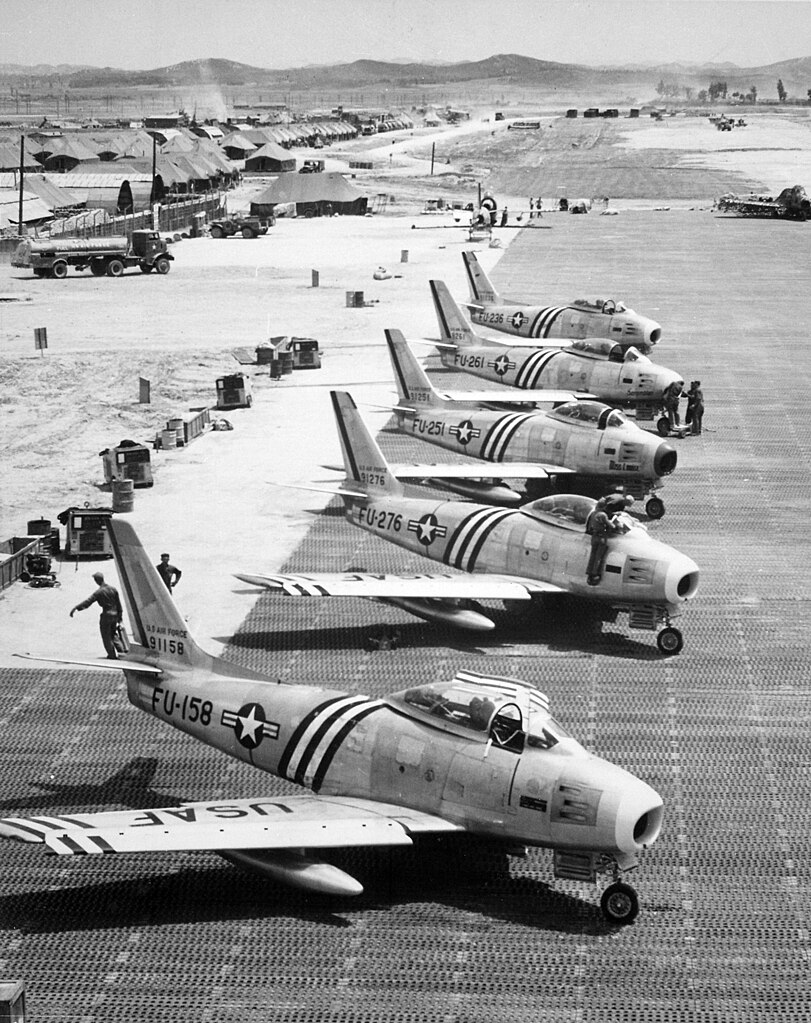
The 4th Fighter-Interceptor Group deployed to Korea in 1950. On 22 December 1950, Captain Roberts was flying one of eight F-86As in an air battle against fifteen Mikoyan-Gurevich MiG-15 fighters. Roberts shot down one of the six MiGs destroyed in the battle. No Sabres were lost. He later shot down a second MiG-15.
Major Roberts resigned from the Air Force in March 1952 and joined North American Aviation as an engineering test pilot. He was involved in testing the F-86H fighter bomber variant of the Sabre, the F-100A Super Sabre, and the F-107A. Roberts was a founding member of the Society of Experimental Test Pilots.
Roberts retired from North American after thirty years.
James O’Connor Roberts, Jr., died at Salinas, California, 6 September 2008, at the age of 84 years.
¹ The Department of Veterans Affairs gives an enlistment date of 17 April 1937.
© 2024, Bryan R. Swopes
“remain proficient” = keep getting flight pay 🙂
☲✪☲ Scatback – 7th Air Force Flight Operations
Mission:
1. Combat courier airlift throughout the Southeast Asia (SEA) theater.
2. Distinguished Visitor (DV) & Very Important Person (VIP) combat theater airlift.
Overview:
“Scatback” was the call-sign of a PACAF squadron-level unit that performed special airlift missions during the war(s) in Southeast Asia. Scatback operated the following airlift aircraft in SEA: T-39A Sabreliner, C/VC-47D Skytrain (a.k.a. Goony Bird), C/VC-54E Skymaster, C/VC-118A Liftmaster, VC-123B/K Provider, and U-3B Blue Canoe.
Scatback missions were managed outside of the more widely known SEA theater tactical airlift system of C-7, C-123, and C-130 transports. Although a squadron-level unit, Scatback’s tasking and scheduling (OPCON) came directly from the flight operations section of HQ 7th AF/DO, Tan Son Nhut Air Base, Republic of Vietnam; and its successor unit: United States Support Activities Group (USSAG)/7th Air Force, relocated from TSN on 29 March 1973 to Nakhon Phanom (NKP) Royal Thai Air Force Base (RTAFB).
The generally accepted activation date for Scatback was November 1965 at Tan Son Nhut AB, RVN and deactivated on 30 June 1975 at NKP RTAFB with the stand-down of USSAG/7th Air Force.
The military unit designation(s) for Scatback changed several times over its 10 years of SEA flight operations, formally starting in November 1965: 6250th Air Base Squadron -Operations Section, 6250th Support Squadron, Det. 1 – 460th TRW, 7th Air Force Flight Ops, 377th ABG & ABW Flight Ops, and from 1973-1975 Scatback Flight Ops, 56th SOW, NKP RTAFB. However, the mission call-sign remained consistent: “Scatback”.
The most ubiquitous Scatback aircraft in-theater was the North American T-39A Sabreliner that landed at every jet-capable allied airstrip in SEA with a runway length of 5,000 ft or more, often two to three times per day, airborne nearly 24 hours/day, 364 days/year (Christmas Day was a 7th Air Force stand-down).
The Scatback aircraft most recognized by personnel of all services stationed in the RVN was VC-123B s.n. 56-4375 (nicknamed ‘The White Whale’) converted into the personal VIP transport for Army General William C. Westmoreland, COMUSMACV.
SEA COMBAT COURIER – HERITAGE:
In an era preceding the http://www Internet, Scatback was best known as the in-theater classified courier airlift system, transporting high priority/small packages throughout the Vietnam and Thailand AOR in a courier program predating what we know today (generically) as FedEx®. The original Vietnam combat courier mission, moving recce film and intelligence products around SEA bases, was performed by available RT-33 T-Bird and RB-57 Canberra aircraft under the OPCON of 2nd Air Division. However, these aircraft proved to be unsuitable and unreliable for the repetitive-cycle combat courier mission and were replaced by North American T-39A Sabreliner courier aircraft in November 1965. Depending on heavy maintenance inspection cycles (IRAN) Scatback’s T-39 inventory typically ranged from eight to ten Sabreliners. Two U-3B (Cessna 310) Blue Canoes were deployed in May 1963 during Operation Farm Gate to transport reconnaissance film and Intel reports to non-jet capable locations, typically SOF bases in III and IV Corps with short or unimproved (PSP) runways.
COMBAT COURIER AIRLIFT MISSIONS
(T-39A & U-3B):
Courier Call signs – Scatback Alpha, Scatback Bravo, Scatback Charlie, and Scatback Delta
Typical combat courier cargo load:
• Elements of the HQ 7th Air Force daily Fragmentary – or “FRAG” – Air Tasking Order (ATO)
• Pre-strike and post-strike photography: Bomb Damage Assessment (BDA), Combat Camera, and Search & Rescue (SAR) reconnaissance photos from RF-101, RF-4C, RB-57E “Patricia Lynn”, U-2 “Giant Nail”, SR-71 “Senior Crown” and AQM-34 Firebee RPV {a.k.a. “Buffalo Hunter”} ISR platforms, and occasional Corona {keyhole} satellite imagery
• • Three photos (of varying scale) were provided to each FRAGed fighter pilot:
1. Area (large scale photo of area)
2. Aim (for getting aiming points)
3. Target (close in)
• Undeveloped fighter gun camera & fire control radarscope camera film cassettes
• Radar/electronic/thermographic sensor reconnaissance products
• Intelligence reports & documents (including US Army “Safe Hands” ?? Intel intercepts)
• High priority NORS-G (a.k.a. NMC-S) aircraft spare parts
• Military Payment Certificates (MPC) script for in-country currency change-out on unannounced “C-Day” or resupply of base finance coffers
• Urgent medical packages that included emergancy whole blood, vacines, even rabid dog cadavers (for rabies testing) and urinalysis samples (for drug abuse testing — Operation Golden Flow)
• Backpack “IFF Transponders” used at ARVN fire support bases in the spring 1972 Eastertide offensive to designate their unit’s position for orbiting AC-130 & AC-119K gunships, firing off-set from overhead
• “Party suites”, ordered by AF aircrews in Vietnam (that could not shop off-base) from “Brother” Singh Vasir Armigit, aka “Fuzzy” (Maharaja Taylor – downtown Udon Thani) and airlifted back to the pilot’s base by Scatback teeny-weeny airlines
• Space Available (Space-A) mil & civilian pax w/ travel orders & SECRET/NOFORN clearance (2-max)
• • Scatback also airlifted a number of combat search and rescue (CSAR) “survivors” from the drop-off point @ the 37th ARRS – Da Nang west ramp; back to the survivor’s home base in Thailand and the RVN.
FYI: We played a very small role in the BAT 21B SAR effort. We airlifted USN LT Tom Norris (MOH)
and USMC LTC Andy Anderson from TSN “Joker” up to Da Nang in early April ’72. Likewise, we airlifted the intelligence packages used to organize the rescue of Lt Col Gene Hambleton (call sign: BAT 21 Bravo). We then airlifted 1st Lt Mark Clark from Da Nang, back to his home base at NKP RTAFB on 12 April 1972.
Note: T-39A Max combined payload was 1,320 lbs (manifested cargo, flight mechanic, tool box, spare MLG tire & space-A Pax)
The T-39s would then ‘Scatback’ to Tan Son Nhut where the film would be developed and analyzed by the 12th Reconnaissance Intelligence Technical Squadron (RITS) …and then repeat the process again the next day. Ergo, the nickname/call sign ‘Scatback’.
Typical Route Structure (circa 1971 – 1972):
Scatback “Alpha” departed TSN in the early morning (before sunrise) and often provided the aircrew with spectacular sunrises above the East China Sea.
Scatback “Alpha” was typically the most intense combat courier mission for both the pilots and the flight mechanic who managed the on-load and off-load of courier packages:
• (Depart) – TSN
• Phan Rang
• Cam Ranh Bay
• Pleiku
• Da Nang (refueling stop on west ALCC ramp)
• Phu Cat
• Tue Hoa
• Nha Trang
• (RTB late morning) – TSN
Scatback “Bravo” was the afternoon mission to Thailand:
• (Depart late morning) – TSN
• Udorn (refueling stop on Base Ops ramp. Visit w/ “Brother” Singh Vasir Amarjit, proprietor of Maharaja Taylor – Party Suites haberdasher. Then, Thai Kobe Steak lunch at the Redwood Inn across from Base Ops.)
• Nakhon Phanom (a.k.a. NKP)
• Ubon (refueling stop on Base Ops ramp, in front of the 8th TFW Wolf Den)
• Da Nang (refueling stop on west ALCC ramp)
• (RTB sundown/dusk) – TSN
Scatback “Charlie” flew all night around Thailand:
• (Night departure) – TSN
• Udorn (refueling stop on Base Ops ramp)
• NKP
• Ubon (refueling stop on Base Ops ramp)
• Korat
• Takhli (added in spring 1972, refueling stop on Base Ops ramp)
• (RTB) – TSN
SEA SAM AIRLIFT – HERITAGE:
The predecessor to Scatback airlift can be traced to the earliest days of U.S. involvement in the RVN with the arrival of the Military Assistance Advisory Group (MAAG) Vietnam in the early 1950’s and the need for a special airlift mission capability, typically with temporary duty (TDY) C-47 Gooney Birds and other propeller-driven light transports.
In mid December 1961 the 464th Troop Carrier Wing and their C-123 Providers began to deploy to South East Asia as part of Operation Mule Train, activating a detachment of 10 C-123s at Tan Son Nhut in January 1962. With the 464th TCW deployment came a special VC-123B s.n. 56-4375 assigned to airlift the commander USMACV and his staff. The airplane was painted with a distinctive white top and unpainted belly, which was shined to a mirror finish. The interior of the airplane was configured with special VIP seating and accoutrements. The airplane was initially nicknamed “Moby Dick” based upon its lumbering flying qualities; however, in 1964 s.n. 56-4375 was renamed “The White Whale” based upon its white-cap livery, becoming the most widely recognized aircraft of the Vietnam War. The aircraft entered the Scatback fleet when the White Whale was reassigned from the 33rd Tactical Group, to Det. 1, 460th Tactical Reconnaissance Wing at TSN. In 1969, this VC-123B (Bravo) was modified into a VC-123K (Kilo) with the installation of two J85 jet engine pods. The auxiliary jet engines increased the White Whale’s payload weight by a third, shortened its takeoff distance, improved its climb rate, and gave a much greater margin of safety should one of the piston engines fail.
In 1961-62, a single T-39A Sabreliner was rotated on temporary duty from other western PACAF bases (initially Clark AB, PI; then Yokota, Misawa, and Kadena AB, JA) and their very small cadre of pilots and maintenance personnel would form a compact TDY Detachment in Base Operations on Tan Son Nhut in support of the U.S. Ambassador’s need for high speed (jet) special airlift missions.
Several C/VC-54E Skymasters were assigned to Tan Son Nhut in 1962 to airlift war-weary U.S. military “advisors” out of Vietnam on R&R to such places as Hong Kong, Thailand and the Philippians.
On 8 July 1963, the various MAAG units on Tan Son Nhut were organized as the unified 33d Tactical Group. As the forerunner of Scatback, the 33rd TG was equipped primarily with cargo aircraft: C-54E, U-3B, VC-47D, and the VC-123B White Whale.
Over time, the TDY T-39 SAM detachment became a PCS assignment at TSN, growing to two and then four permanently assigned Sabreliners by 1965, keeping up with the expanding role of the U.S. military in Vietnam.
DV/VIP COMBAT THEATER SPECIAL AIRLIFT MISSIONS
(T-39A, VC-47D, VC-54E, VC-118A, VC-123B, and U-3B)
SAM call signs – Scatback Echo, Scatback Foxtrot, Scatback Gulf, H, I, J, etc.
Scatback Quebec was typically reserved for VC-118A US Ambassador, and DV/VIP missions.
Typical combat SAM manifest:
Scatback airlifted many of the key DV/VIP leaders who were managing the Vietnam War, and the smaller regional-wars throughout Southeast Asia. “Over-the-fence” low-profile SAM missions included (C-01) Pochentong airfield, Phnom Penh, Cambodia; and Lima Site 08 – Wattay Airfield, Vientiane, Laos.
Scatback DVs & VIPs included the Vice President-USA, Secretary of State, Secretary of Defense, US Senators & Representatives, US Ambassador to the RVN, Chairman-JCS, Service Secretaries & Military Chiefs, CINCPAC, COMUSMACV, 7th Air Force/CC, and a variety of lower ranking Flag & General Officers {and civilian equivalents, e.g. asst. SecState, asst. SecDef, Bob Hope-USO, etc., IG & Staff Assistance teams …and CONUS staffers visiting the Orient, apparently as Christmas-shoppers}.
I was crew chief on 60-3477 in the 23 FMS, Base Flt. McConnell AFB, 1966-68.
Our 39’s were used for training F-105 crews on Wild Weasel. The plane was equipped with 2 training consoles in the aft compartment.
Gordon E Hahn, SGT E-4.
Loved every minute of it…??
The only business jet certified for aerobatics. The airplane was also used for upset-recovery training including full stalls, inverted flight, and up to 40 deg dives within its design load limit.